The off price retail market is estimated to be valued at USD 372.46 Bn in 2025 and is expected to reach USD 668.30 Bn by 2032, exhibiting a compound annual growth rate (CAGR) of 8.7% from 2025 to 2032.
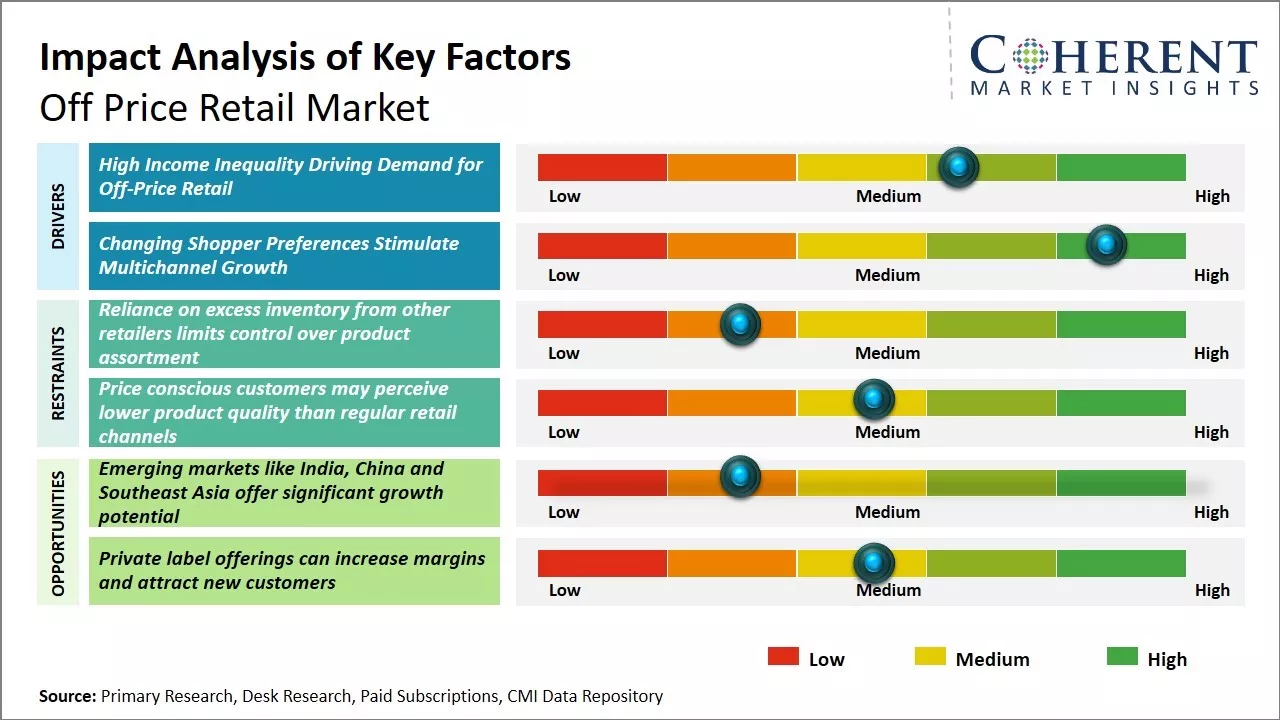
Discover market dynamics shaping the industry: Request sample copy
The sector has benefitted from consumers' attraction towards discounted designer and name brand apparel and accessories. Fast fashion trends that have made consumers switch wardrobes quickly and spend less on each individual garment has further stimulated market expansion. Increased disposable incomes and rising popularity of online shopping amongst younger consumers have additionally supported off price retail sector revenues. However, market players may face challenges from improving economic conditions that could see consumers switch back to full-priced stores again.
High Income Inequality Driving Demand for Off-Price Retail
Income inequality in developed economies has been steadily increasing over the past few decades and this trend will continue into the future. As the gap between high and low income individuals widens, the lower and middle class feel considerable financial pressure to carefully budget their spending. Off-price retail has emerged as an attractive option that allows value conscious shoppers to purchase brand name products at significant discounts compared to traditional retailers. By offering desirable fashion and lifestyle items from top designers and brands at 30-60% lower price points, off-price retailers enable more Americans to affordably indulge in conspicuous consumption without overspending. The psychological need to perceived oneself and family as keeping up with latest trends drives many customers to off-price chains. Here they can find top season's styles and stay consistent with their peers without breaking the monthly budget. Particularly for those with children and young families, cost savings help allocate limited funds across other necessities as well like housing, education, and healthcare. The experience of shopping at outlet malls and big box discount retailers has also become a popular weekend activity and source of entertainment for lower income groups. While the products may not be brand new or in style for the current season, off-price provides sufficient selection and new arrivals to satisfy visual tastes on a constrained income.
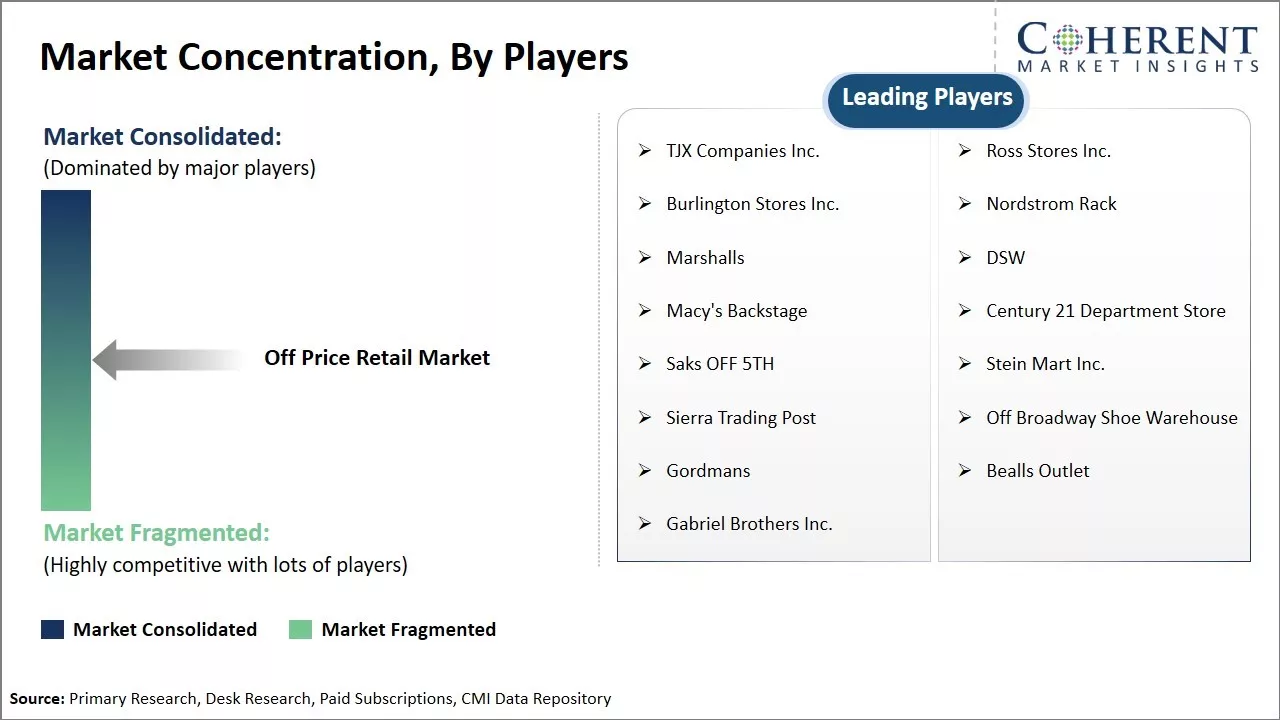
Get actionable strategies to beat competition: Request sample copy
Changing Shopper Preferences Stimulate Multichannel GrowthCustomer shopping preferences and behaviors have radically transformed over the past decade with the rise of ecommerce and online platforms. Off-price retailers recognized this evolving landscape and proactively expanded their multichannel strategies. Where once shoppers would exclusively hunt for discounts at brick-and-mortar outlet stores, now off-price chains seamlessly integrate the in-store and digital experiences to meet consumers wherever most convenient. Features like buy online pickup in store, free shipping minimums, and mobile apps allow busy households to conveniently discover deals, plan purchases, and execute transactions however fits their schedule. Retailers also gain invaluable shopper data and insights from robust websites and apps to better tailor assortments and messaging. Customers coming online initially for information gathering or inspiration increasingly complete transactions via the digital channels. During COVID-19 quarantines, off-price businesses with versatile ecommerce infrastructure were able to continue operations and maintain cash flows while many competitors shut down.
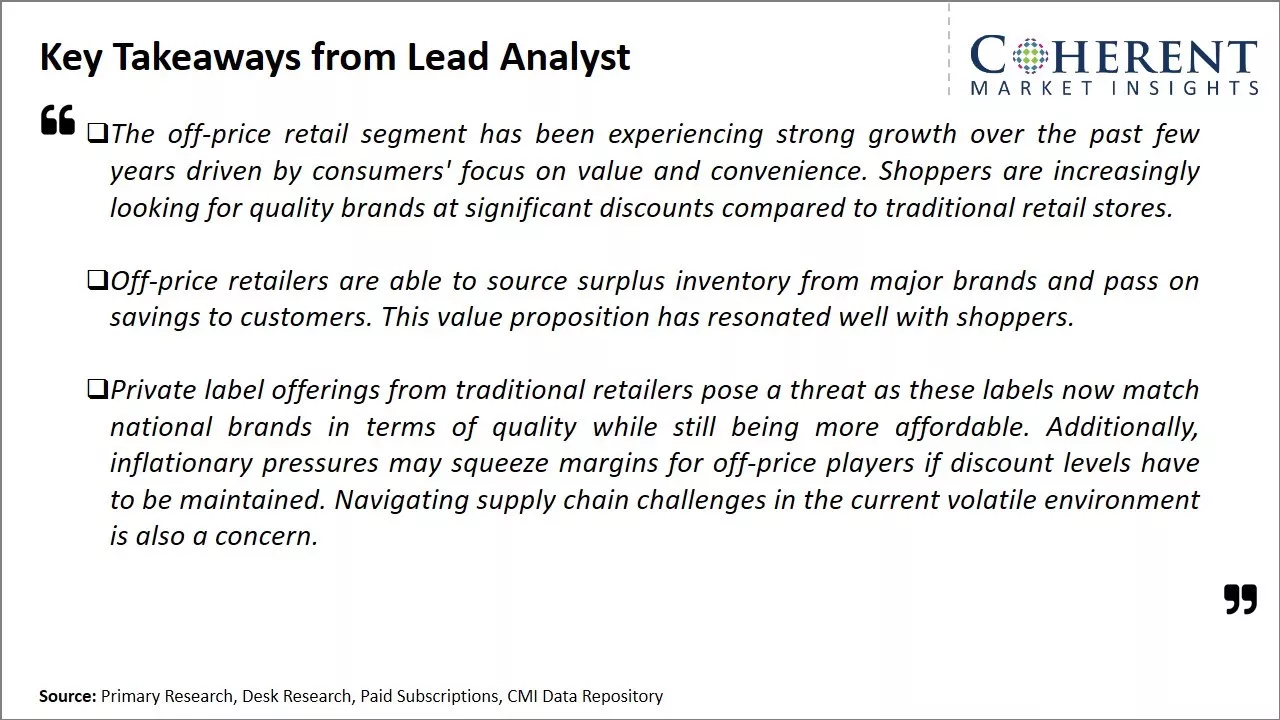
To learn more about this report, Request sample copy
Challenge: Reliance on excess inventory from other retailers limits control over product assortmentOff price retailers are increasingly relying on purchasing excess inventory from other retailers rather than procuring goods directly from brands and manufacturers. While this allows them to offer discounts on branded goods, it also limits their control over the product assortment available in stores. When a retailer is dependent on other retailers' excess stock, they have little say in the types of products, styles, sizes or quantity of items they receive. This can negatively impact the customer experience at off price stores. Customers visit off price retailers expecting to find a wide variety of fashionable and popular brands at low prices. However, if the inventory received is random and uncurated, they may not find their preferred styles or sizes in stock. With no control over procurement, off price retailers cannot tailor the assortment based on customer demand, trends, seasonality or feedback. They also cannot guarantee supply of perennial best-selling lines. This unpredictability in availability of goods results in an inconsistent and haphazard shopping experience for customers. It can diminish their confidence in the off price concept and reduce repeat visits.
Opportunity: Emerging markets like India, China, and Southeast Asia offer significant growth potential
Emerging markets like India, China, and Southeast Asia are experiencing rapid economic development and increasing consumer spending. With growing middle-class populations that are embracing Western brands and styles, these markets represent massive opportunities for off-price retail chains to gain new customers. As incomes rise across Asia Pacific and barriers to imported goods decrease, the demand for affordable luxury and name-brand fashion is surging. Off-price retailers are well-positioned to capitalize on this demand by offering designer and premium labels at significant savings compared to full-priced stores. International organizations project continued strong economic expansion in emerging markets over the next decade. For example, the World Bank estimates India's GDP will grow by over 6% annually through 2023. As developing countries industrialize and urbanize at a fast pace, more residents will enter the workforce with higher disposable incomes. This will drive further spending on discretionary items like clothing and accessories. Off-price retail offers excellent value that appeals to new consumers entering the middle class. Their treasure-hunt shopping experiences in stores mimic the enjoyment of full-price luxury, while staying within household budgets.
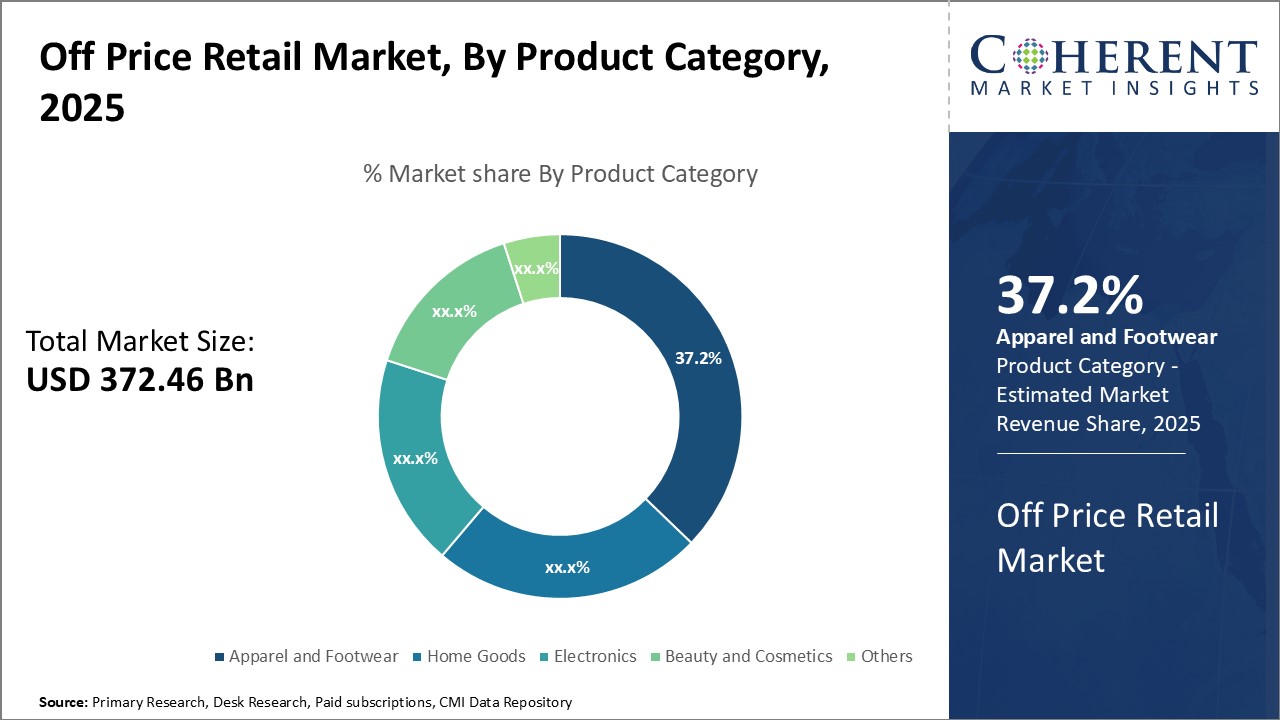
Discover high revenue pocket segments and roadmap to it: Request sample copy
Insights by Product Category: Fashion forward trends drive apparel and footwear segmentIn terms of product category, apparel and footwear are expected to contribute 37.2% share of the market in 2025, owing to constantly changing fashion trends. As off-price retailers source inventory opportunistically, they are able to offer the latest styles at significant discounts compared to other retailers. This allows consumers to indulge in fashionable looks without breaking the bank. Younger shoppers in particular appreciate being able to attain affordable versions of runway styles. Off-price retailers are also dexterous at anticipating trending silhouettes, fabrics, and details season after season. Their up-to-the-minute selections satisfy consumers' desires to stay on-trend without paying full-price.
Insights by Price Range: Value and variety attract consumers to the mid-range price segment
In terms of price range, the mid-range segment is expected to contribute 39.1% of the market share in 2025, due to the attractive balance it offers between affordability and quality. Consumers can find durable, appealing items at discount prices that fit neatly within most household budgets. The mid-range caters to a diverse array of needs through its wide assortment spanning apparel, home goods, accessories, and others. Shoppers appreciate the choice that allows them to selectively stock up on essentials and treats. They also feel comfortable exploring new categories at off-price value prices in the mid-range, versus sticking strictly to necessities at the low-end.
Insights by Demographics: Women devote more time and budget to self-care shopping
In terms of demographics, the women segment is expected to contribute 40.3% of the market share in 2025, owing to females traditionally dedicating more discretionary funds to their wardrobes and looks. Women enjoy indulging in beauty and fashion purchases to treat themselves. They also fulfill roles like clothing their families that contribute to larger shopping baskets. Additionally, societal standards have long placed greater emphasis on a woman's appearance, further driving female consumers to off-price retailers' diverse selection of apparel, footwear, accessories and beauty products. These factors motivate women to spend more than other groups in the market.
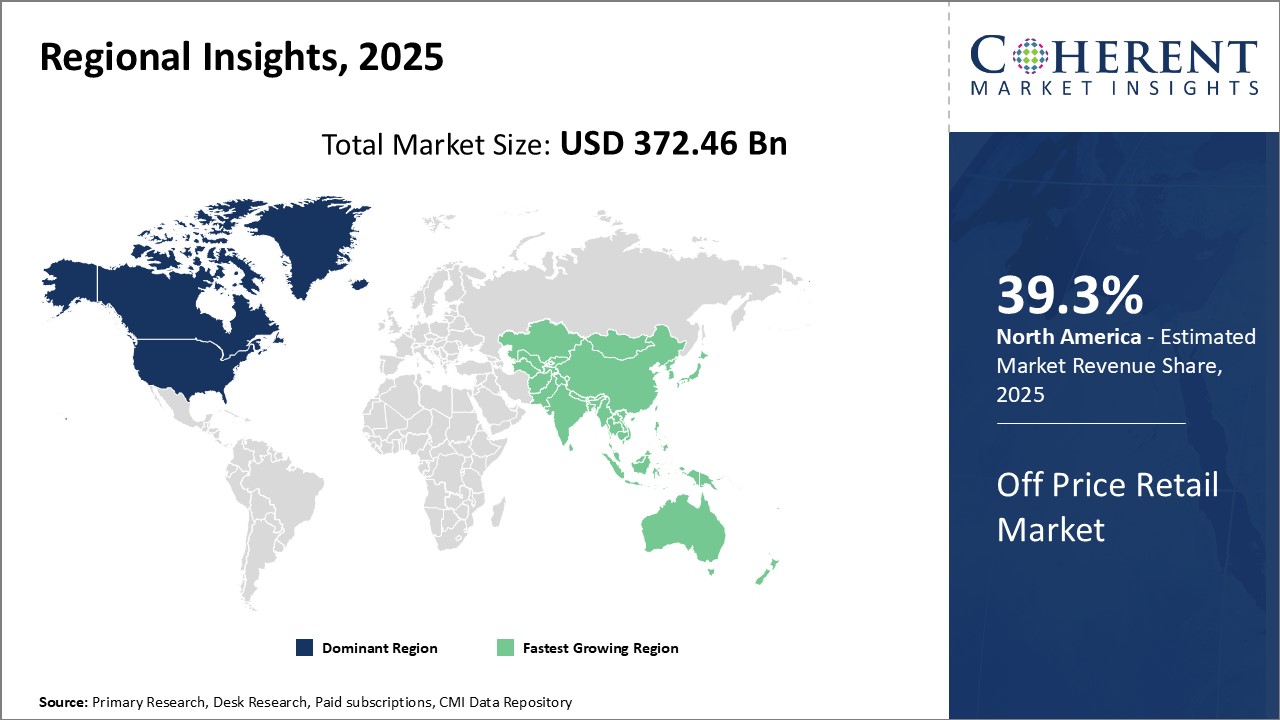
Need a Different Region or Segment? Customize now
The North America region, particularly the U.S., has long dominated the global off-price retail market. The region is expected to account for 39.3% of the market share in 2025. With a highly developed consumer economy and vast network of highways and interstates enabling efficient logistics, the vast geography of the U.S. has allowed off-price chains to establish widespread store coverage across the country. Chains like TJX have mastered the model of sourcing excess inventory from name-brand designers and manufacturers, and distributing these deals to locations within a day's drive of consumer population centers. The density of population in major U.S. metro areas also means off-price shopping remains a cost-effective leisure activity. Consumers regularly visit their local TJ Maxx or Marshalls stores to discover the latest brand-name fashions at significant discounts. The off-price model has been refined over decades in the U.S. to a high-science, with companies maximizing inventory turns and minimizing costs to ensure profits on even steep discounts. No other market rivals the operational efficiency and scale of off-price leaders like TJX in North America.
While North America remains the dominant force, the Asia Pacific region is emerging as the hottest growth opportunity for off-price chains. Countries like China and India boast massive populations of emerging middle-class consumers, many influenced by pop culture trends from Western brands. The absence of major domestic off-price competitors means international operators have significant room for expansion. Factors like a growing emphasis on value among Chinese consumers are boosting the appeal of branded treasures at a bargain. Beyond traditional retail hubs of India and China, other Southeast Asian markets like Vietnam and Indonesia are seeing especially rapid wage and GDP growth. The influx of disposable consumer income in dynamic economies makes off-price an attractive proposition. Moreover, governments in Asia Pacific have prioritized infrastructure development like airports and highways that ease logistics. Off-price leaders will be well-positioned to benefit by establishing early beachheads as Asian consumers' appetite for discounted designer brands continues expansion.
Off Price Retail Market Report Coverage
| Report Coverage | Details | ||
|---|---|---|---|
| Base Year: | 2024 | Market Size in 2025: | USD 372.46 Bn |
| Historical Data for: | 2020 To 2024 | Forecast Period: | 2025 To 2032 |
| Forecast Period 2025 to 2032 CAGR: | 8.7% | 2032 Value Projection: | USD 668.30 Bn |
| Geographies covered: |
|
||
| Segments covered: |
|
||
| Companies covered: |
TJX Companies Inc., Ross Stores Inc., Burlington Stores Inc., Nordstrom Rack , Marshalls , DSW , Macy's Backstage , Century 21 Department Store, Saks OFF 5TH, Stein Mart Inc., Sierra Trading Post , Off Broadway Shoe Warehouse, Gordmans , Bealls Outlet , Gabriel Brothers Inc. |
||
| Growth Drivers: |
|
||
| Restraints & Challenges: |
|
||
Uncover macros and micros vetted on 75+ parameters: Get instant access to report
*Definition: An off-price retail market refers to retailers that sell brand name merchandise at discounted prices, typically 20-60% below typical department and specialty store regular prices. Off-price retailers buy unsold inventory from manufacturers, brands, and other retailers and resell it quickly at a lower price in their own stores. They offer frequent new product assortments and treasure-hunt shopping experiences where customers never know what brands or styles they might find.
Share
Share
About Author
Ankur Rai is a Research Consultant with over 5 years of experience in handling consulting and syndicated reports across diverse sectors. He manages consulting and market research projects centered on go-to-market strategy, opportunity analysis, competitive landscape, and market size estimation and forecasting. He also advises clients on identifying and targeting absolute opportunities to penetrate untapped markets.
Missing comfort of reading report in your local language? Find your preferred language :
Transform your Strategy with Exclusive Trending Reports :
Frequently Asked Questions
Joining thousands of companies around the world committed to making the Excellent Business Solutions.
View All Our Clients
US Reciprocal Tax Impact Analysis On Off Price Retail Market
Stay updated on tariff changes with expert insights and timely information